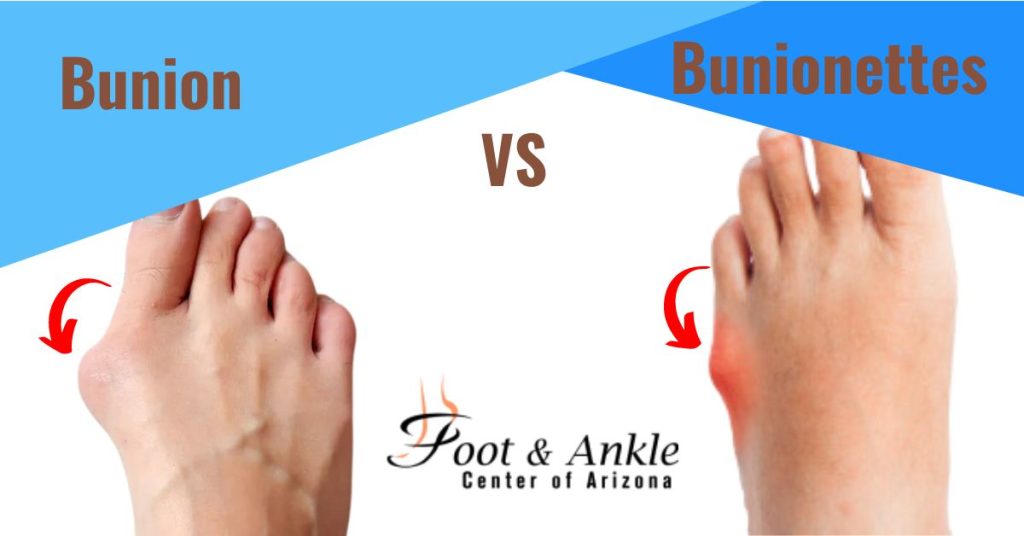Foot and ankle center of Arizona, our podiatrist Dr. Kris DiNucci, D.P.M. FACFAS, is well conversant with a range of conditions in the foot and ankle such as bunions and bunionettes. Our team at Foot and ankle center of arizona, the top mica bunion surgery service provider in Scottsdale, AZ is committed to educating patients on the distinctions between bunions and bunionettes plus their treatment choices.
Understanding Bunions
A bunion, also known as a hallux valgus, is a bony bump that forms at the base of the big toe. This deformity occurs when the big toe starts to deviate towards the smaller toes, causing the joint at the base of the big toe to protrude outward. An assortment of factors such as heredity, wrong foot mechanics and wearing shoes that don`t fit well can cause bunions.
Bunions can be a source of significant discomfort and pain, making it difficult to wear shoes comfortably and perform everyday activities. The protruding joint can also lead to the development of corns, calluses, and even arthritis in the affected joint.
Understanding Bunionettes
In contrast, a bunionette, also known as a tailor’s bunion, is a bony protrusion that forms on the outside of the little toe joint. This condition is often caused by the same factors that lead to the development of a traditional bunion, such as heredity and improper foot mechanics.
Like bunions, bunionettes can be a source of pain and discomfort, making it difficult to wear shoes and perform daily activities. Bunionettes can also lead to the development of corns, calluses, and even arthritis in the affected joint.
Key Differences Between Bunions and Bunionettes
Despite the similarities between bunions and bunionettes, there are a number of distinct factors that distinguish one from the other:
Location: for instance, bunions appear at the base of the big toe while bunionettes emerge at the base of the little toe.
Appearance: in contrast with bunionettes which show up as a bone projection on outer side of foot. Normally bunions are seen as a bone protuberance inside feet.
Prevalence: 23% of adults aged between 18-65 are believed to have bunions compared to those suffering from bunionettes.
Underlying Causes: heredity, poor foot mechanics can cause both conditions. However bunions tend to be more associated with wearing tight shoes whereas bunionettes are often attributed to wearing high heels.
Frequently Asked Questions (FAQs)
What is the difference between a bunion and a bunionette?
The primary difference between a bunion and a bunionette is that the two are located differently. A bunion occurs at the base of the big toe while a bunionette occurs at the base of the little toe.
How do I know if I have a bunion or a bunionette?
If you see bone sticking out on the inside part of your foot close to your big toe, it’s possible that it’s a bunion. On the other hand, if you have outwardly protruding bones near your little toes on your feet, then it might be bunionettes. It is wiser to consult with a podiatrist like Dr Kris DiNucci DPM FACFAS for proper diagnosis
Can they be treated the same way?
Even though conservative methods such as taping, physical therapy or wearing orthotics are applicable in both bunions and bunionettes, surgical treatments may differ. Bunion surgery is often more complicated compared to bunionette surgery and also takes longer to heal.
How can I prevent the development of a bunion or a bunionette?
Properly fitted shoes will help prevent bunions and bunions. Additionally, staying fit as well as doing foot exercises regularly can also lower the likelihood of these conditions occurring.
When should I seek treatment for a bunion or a bunionette?
Signs that you need to see a doctor for podiatry treatment include continuous pain, problems with walking and inability to wear shoes comfortably due to the presence of a bunion or a tailor’s bunion. Dr. Kris DiNucci, DPM, FACFAS is one of such experts. It is necessary to undergo the required medical care early enough since it may help in stopping the advancement of this disorder and hence reducing the need for more advanced remedial options.
The Foot and Ankle Center of Arizona appreciates the fact that we must give our patients necessary information on their foot health so that they can decide how to go about it. Our group of well experienced podiatrists including Dr. Kris DiNucci, DPM FACFAS, is here to help you in case you have a bunion, a bunionette or any other condition that affects your ankle or foot. Do not hesitate to reach out to us today if you need an appointment and more information on our comprehensive bunion surgery, its pain, treatment and recovery time-based services.




